-
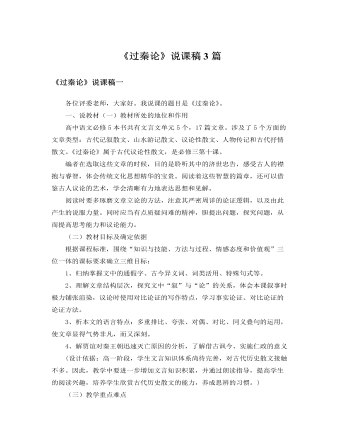
人教版高中语文必修3《过秦论》说课稿3篇
本文篇幅较长,并且有一字句不易理解,因而对高一学生来说完全读懂内容有一些困难。这样的话,老师就要做好引导工作,把一些难点,或是出现词类活用比较多,局势比较特殊的句子,老师可以先给学生画出来,存疑,或是与同学们一起讨论解决。对那些不易懂的字词就引导学生联系上下文提供的语境、前后涉及的情节加以推测、判断,以培养学生依据文脉推断词义的好方法。要求学生点出重点实词、框出通假字,主要是为帮助学生积累和掌握一些文言文中常见的一词多义、异读现象、古今异义和通假现象的词语,并进一步得出规律,指导今后的文言文学习。词类活用和特殊句式在文言文翻译中难度较大,也是本文教学的两大难点。要求学生标出有活用现象的字和划出句式特殊的句子,是基于两点考虑:1、积累一定数量的第一手例句;2、引导学生加以分类,找出每类的相同特征,并抽取出来形成规律性的东西,从而上升到理性认识,使学生能由学会一个到会学多个。翻译过程中注重指导学生养成用符号法表示重点字句的好习惯,如点、框、圈、划线等符号应约定一致,便于突出翻译中的重点、难点及复习。我的提示着重归纳了实词“制”“亡”“遗”“利”等,名词活用、形容词活用、使动用法,被动句、状语后置句。
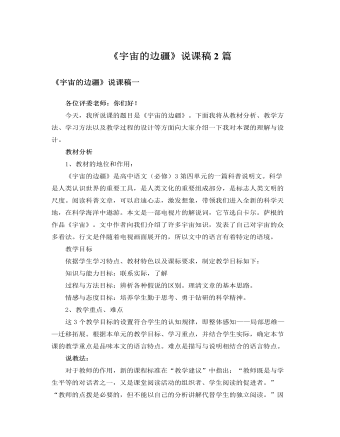
人教版高中语文必修3《宇宙的边疆》说课稿2篇
(有的恒星旋转平稳均衡,有些恒星是因快速旋转而变了形。作者以拟人的手法,生动形象地描述,仿佛向我们展示了不同恒星的性情:有的稳重沉静,有的急切躁动。读来生动有趣,妙趣横生。)(3)我们探索宇宙的时候,既要勇于怀疑,又要富于想象。想象经常能够把我们带领到崭新的世界,没有想象,我们就处处碰壁。怀疑可以使我们摆脱幻想,还可以检验我们的推测。(对于未知领域的探索是需要怀疑和想象的,想象是科学的翅膀,敢于想象,并不断地探索验证,所谓“大胆假设,小心求证”怀疑否定旧知,产生新知。作者以简洁的语言阐述了想象和怀疑看似矛盾的两者在宇宙探索中的相辅相成,和谐统一。作者不囿于介绍宇宙知识,还发表自己的见解。)(4)我认为宇宙里很可能到处都充满着生命,只是我们人类尚未发现而已。我们的探索才刚刚开始。
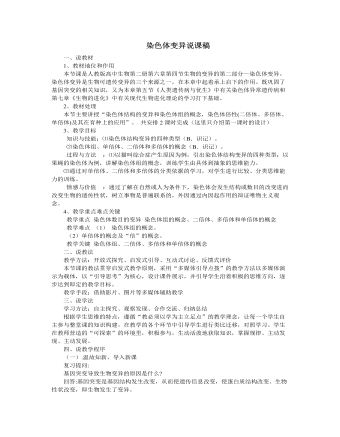
人教版高中生物必修2染色体变异说课稿
四、说教学程序(一).温故知新、导入新课复习提问:基因突变导致生物变异的原因是什么?回答:基因突变是基因结构发生改变,从而使遗传信息改变,使蛋白质结构改变、生物性状改变,即生物发生了变异。那么,基因是什么?它和染色体又有何关系?回答:基因是有遗传效应的DNA片断,染色体是DNA的载体,基因在染色体上呈线形排列。引出新知:对于一个生物体来说,正常情况下,其染色体的结构和数量都是稳定的。但在自然条件或人为因素的影响下,染色体的结构和数量均会发生改变,从而导致生物性状的改变,这就属于染色体变异。(二).把握重点、突破难点重点的把握:1、染色体结构的变异播放影片:猫叫综合征幼儿。让学生观察: 患儿哭声轻、音调高,很像猫叫。教师补充: 患儿的征状---两眼较低、耳位低下,存在着严重的智力障碍。阐述病因---染色体片段缺失

人教版高中英语必修1English around the world说课稿
(3)v. 给:提出;展现,显现present sb. with sth. ; present sth. to sb. 把. . 交给;颁发;授予present sth. (for sth. )/present sth. to sb. e. g. Om his birthday, his friends presented him a collection of stamps. 在他生日时,他的朋友们送给他一套邮票作为礼物。The sword was presented by the family to the museum. 这家人把宝剑捐赠给了博物馆。The committee will present the final report to Parliament in June. 委员会将在六月向议会提交最后的报告。You need to present yourself better. 你需要更善于展现自己。It is essential that we present a united front. 至关重要的是我们要表现得更加团结。Step 4 ConsolidationT:Now that we have got a general idea of these words and phrases. Lets make up some sentences using them to master them. Suggested sentences:1. Your duties include typing letters and answering the telephone. 2. It is one of the greatest roles that she has played. 3. A large number of people have applied for the job. 4. The number of the panda is declining. 5. I'11 go there, even if I have to walk. 6. He came up to me to ask for a light. 7. The novel is about a family who can't communicate with each other. 8. He based his plan on interests of most people. 9. Why doesn't he make use of his singing talent?Step 5 Summary and homeworkT:Today we dealt with several new words and phrases. After class I hope that youcan read them again and again to keep them in mind. That's all for today. You aredismissed.

人教版高中英语必修2Computers说课稿3篇
一. 教材分析1. 本单元的中心话题是“计算机(Computers)”,内容涉及计算机的发展历史,计算机的应用等。本节课是该单元的第一课时,我将Warming up, Pre-reading and Comprehending这四部分整合为一节精读课。其中。Reading部分是题为WHO AM I?的文章,以第一人称的拟人手法介绍了计算机发长演变的历史和计算机在各个领域的应用,其主旨是表达计算机的发展变化之快以及在生活中用途之广。而Warming up部分以图片的形式展现了计算机的发展历程;Pre-reading中的问题和排序分别是为了预测语篇的内容和测试学生对计算机历史了解的情况;Comprehending则通过各项练习训练学生的阅读技能,从而加深对文章的理解。可见这几部分是一个有机的整体。2. 教学目标:1) 语言目标:重点词汇及短语:abacus, calculate, calculator, PC, laptop, PDA, robot, analytical, technological, universal, mathematical, artificial, intelligent, network, explore, in common, as a result.重点句子:a. My real father was Alan Turing, who in 1963 wrote a book to describe how computers could be made to work, and build a “universal machine” to solve any mathematical problem.

人教版高中英语必修2Wildlife Protection说课稿3篇
When it comes to the students’ studying methods, I'd like to introduce my Ss first. The Ss have a good command of basic language points. They’re interested in learning English, and they take an active part in English class, so they will have fun in autonomous, cooperative and inquiry learning. I will just serve as a guide, showing them the way to explore how to make more progress in their English learning.Now it’s time for the most important stage of this lesson. My teaching procedures are arranged as follows:Step1.Leading-in (3 minute)Play a video of a wide variety of wildlife to introduce my topic. Step2. Speaking (12 minutes)We will use our textbook Page25. Let the Ss fast read the short paragraph to warm up. Ask them to talk about the report on some endangered wildlife in China with the dialogue patterns on the screen. Lastly, I will invite some groups to demonstrate their dialogues about saving wildlife in China.Step3.English play (3 minutes)Watch another video in praise of their excellent performance just now. It’s about Jack Chen’s(成龙)and Yang Ziqiong’s wildlife protection.Step4. Listening (twice 13 minutes)This time, I’ll ask the Ss to fill in the blanks of the monologue of the 2 movie stars above. Step5.Discussion (3 minutes)Which would you like to choose to wear, clothes made of cotton, artificial leather or animal skins? Why ?Step6. Summary (3 minutes)1. If there were no wildlife, there wouldn’t exist human beings. If the buying stops, the killing can, too.2. Animals are our friends. To love animals is to love ourselves. Stop hunting, killing and destroying wildlife.3. Let’s live in harmony with all the living things in the world. Step7. Music appreciation (3 minutes)Let the Ss appreciate the song Earth Song by Michael Jackson. Last but not the least, I will show you my blackboard design.

人教版高中英语必修4A taste of English Humor说课稿3篇
Then I would ask them to think of a funny English or Chinese and tell it to partners. While telling stories, they can use expressions and some acting to help make the story funny. 5 minutes would be given to do this.Those stories they told there will be the material for their writing. Soletting them tell it at first is helpful. And they can make a difference between telling a funny story and writing it down. Generally speaking, it is difficult forstudents to write well because they don’t know what to write and how to write. Asking them to tell their own stories at first can help them come up with what to write.After their telling, I would invite someone to share his/her story with all of us and I would write it down on the blackboard.This example story would be used as a sample to illustrate the format of funny story. Different from a story from teacher or textbook, a story from students can obviously become a interesting material to draw students’ attention.Then I would ask the whole class to put this story into several parts. It might be a little bit difficult for them. So I would ask them to find out whether all the sentences are necessary. After delete some sentences, there are 6 sentences left behind. Then they can easily put them into three parts. After interaction with students, I would teach them the right terms for each part and conclude the format of funny story.This step is the key and difficult point in my lesson. So I mainly usetask-based teaching method in this part and the task for students was divided into several stages. With the separated difficult level, students can find there are usually three parts in writing. They can also learn to write without the unnecessary parts in the process of analyzing. And then I wouldn’t rush to tell them the right terms to them directly. Instead, I would ask them to name them by their own. A confused mind is better for acquiring knowledge.While-writing:Then I would give students 7 minutes to write down this story, without other requirements.With all the preparations in pre-writing, students’ difficulties were cleared. So it would be much easier for them to write down the story within 7 minutes. There are no other requirements because students’ first writing is actually a drafting. It would be revise and edit several times later. Writing, as a skill

人教版高中英语必修4Theme parks说课稿3篇
The oldest and the most popular park in the worldenjoy the exciting activities thereget close to the life-size cartoon characters like Mickey Mouse and Donald Duck Step 3 Pre-reading1.What do you suppose a theme park is ?2.What do you think you can see in a theme park?(1.It is a kind of amusement park which has a certain theme – that the whole park is based on. 2.buildings, castles, statues, rare animals and birds, and so on.) Step 4 Reading ----- Theme Parks –---- Fun and More Than Fun1.Predict : Read the title and the pictures on P. 34 and PredictWhat is the meaning of the title “Theme Park – Fun and more than fun”?(The title means that theme parks are fun to visit, but that they can also be educational and can offer useful information.)2.Skimming Fast read and answer:What activities can we take in a theme park?Amusement park: Bumper car Merry-go-round slide bungee jumping Free-fall rides Horror films Pirate ship Ferris wheel roller coaster3.Scanning Read again and you will find various theme parks are mentioned in the passage . Then what are they ?Theme parks: Sports theme park History theme park Culture theme park Marine or Ocean theme Park Future park Science theme park Disneyland4.Careful reading and find the main idea of each paragraph:THEME PARKS---- entertaining/ educationalPara.1 Traditional parks are places to go for relaxation and to have time away from our busy lives.Para.2 Theme parks are different They’re large and full of things to do, see and buy.Para.3 Theme parks are built around a single idea or theme. One example is a sports park.Para.4 Another kind of theme park is historical more and cultural and can be educational.Para.5 Disneylandwas the first theme park. It is based on the fantasy life and characters of Disney’s films.Para.6 Some examples of educational theme parks include sea world parks and science parks.

人教版高中英语必修3Healthy Eating说课稿4篇
Language learning needs a context, which can help the learners to understand the language and then can product comprehensible output, so computer has the advantages to make the materials attractive.Part 3 Learning MethodsTask-based, self-dependent and cooperative learningPart 4 Teaching ProcedureStep One Lead-in“Interest is the best teacher.” Therefore, at the very beginning of the class, I should spark the students’ mind to focus on the centre topic “the band”. I’ll show some pictures of food to attract their attention and then bring some questions.Question:What kind of food they like?What should go into a good meal?The answers must relate to the diet. After this, the students will be eager to know something about a balance diet and this is the very time to naturally lead the class into Step 2Step 2 Reading for information: skimming and scanning In this step, I use Task-based Language Teaching method, which can give students a clear and specific purpose while skimming and scanning the context.Task 1 General ideaThe students will be asked to just glance at the title and the pictures of the passage, and then guess what they will read in the text. And they’ll be divided into groups of four to have a discussion.The purpose is to inspire the students to read actively, not passively. In addition, the task is to develop the students’ reading skill by making prediction and to encourage the students to express their thoughts in English and cooperate with each other.Task 2 Main idea of each paragraphCooperative learning can raise the students’ interest and create an atmosphere of achievement. Based on this theory, I divide the whole class into 4 groups to skim the whole text and get the main idea of each paragraph.

人教版高中英语必修5Great scientists说课稿4篇
通过写文章梗概,培养学生综合运用语言的能力,学习用恰当的英语描述科学家的故事。这是本课的教学难点。教师可以使用完形填空的方式来帮助学生整理语篇,从而来降低难度。本课的教学重点的突破方法是:在阅读前,让学生初步了解得出科学观点所需要的基本程序,从而轻松而自然地导入文章的阅读;在阅读过程中,由易到难设计快速阅读和精读的问题,层层推进各种阅读活动,让学生对阅读内容从整体感知到细节理解,最后深层读懂整篇文章,同时加强阅读策略的指导,让每个学生都主动参与课堂教学活动,最终达到提高阅读能力的目的。Step 4 Post-readingGroup Activities四人小组共同合作,在老师的适当指导下,就以下2个问题展开讨论,让学生就所知、所学、所感和所想融入话题,然后抽若干同学代表作小组发言。1. What do you think about John Snow, and what should we learn from him?2. Cholera was 19th century disease, which two diseases are similar to cholera today? Why?

人教版高中英语必修5Life in the Future说课稿5篇
Good afternoon, everyone. It’s my great pleasure to be here sharing my lesson with you. The content of my lesson is Senior English for China Book5 Unit 3 Life in the Future. I’ll be ready to begin this lesson from six parts: Analysis of the teaching material, Analysis of the students, Teaching aims and important and difficult points, Teaching methods and aids, Teaching procedures, and Blackboard design. First, let me talk about the teaching material.Part 1 Analysis of the Teaching Material:This unit is about what human beings’ life will be like in about one thousand years. By studying of this unit, we’ll Enable the students to know the changes in humans’ life and some new inventions bringing about the change and develop the interest in science. This lesson plays an important part in the English teaching in this unit. This is an important lesson in Book Five. From this lesson, it starts asking the Ss to grasp contents of each passage. Therefore, this lesson is in the important position of the teaching material. If the Ss can learn it well, it will be helpful to make the Ss learn the rest of this unit.Part 2 Analysis of the SsAs Senior2 Ss, they are at different levels of English fluency, some of them have lost interest in English. So during the lesson, I arrange a variety of activities to let all of them join in to attract their interest and let them be confident and taste the joy of success.
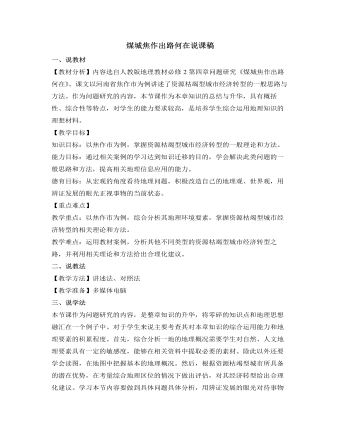
人教版高中地理必修2煤城焦作出路何在说课稿
分析过焦作市的地理概况和产业优势后,就需要针对由于资源枯竭所带来的问题提出合理化的建议。既然是谈经济转型,就应该将话题的范围明确在这一领域内。通过材料3的相关内容,我们了解到焦作市需要在产业结构调整、培育新的优势产业、增强综合竞争力等三个整改方针上下功夫。因而引导学生针对优势与不足提出建议,以三个整改方针为基准,衡量建议的可行性是锻炼学生解决此类问题的有效途径。在此我将教会学生的是解决问题方法而非案例的内容,正所谓“授之以鱼,不如授之以渔”。接下来针对学生的建议和教材资料分析所罗列的10点整改思路,由学生自由发言提出看法,通过教师的指导和学生的讨论,进而确定经济转型建议的具体方案。最后注意将建议与产业优势相对照,看建议是否都是围绕着产业优势而提出的,这样做会加深学生的印象,通过建议和优势的对应关系,将不难找出此类问题的解题思路。

中班听说《猜莲子》说课稿
(一)游戏导入。在这个活动的开始,老师和孩子们围坐成半圆形,这样就自然地缩短了老师和孩子们之间的距离,孩子们会觉得老师很亲近自己,为游戏情景的设置打好了情感基础。接着,老师出示莲蓬剥出莲子“这是什么呢?对,莲子。我们要在池塘里种上莲子,明年才能结出莲蓬。今天,请小朋友扮演池塘里的泥,老师把这颗莲子种到池塘里,大家一起玩一个种莲子的游戏。”良好的游戏情景自然的设置好了,这也是激发孩子们参与的兴趣、集中孩子们注意力的一种很好的策略。(二)交代游戏规则及玩法。游戏规则有以下几点:1、扮泥的小朋友必须将眼睛闭起来,不能偷看,等儿歌念完后才能睁开。2、种莲子的人会在儿歌结束前将莲子放在一个小朋友的手里,并且用简短的语言来描述这个小朋友的外貌特征,请大家来猜。3、被猜出的小朋友必须重复说出自己的外貌特征。
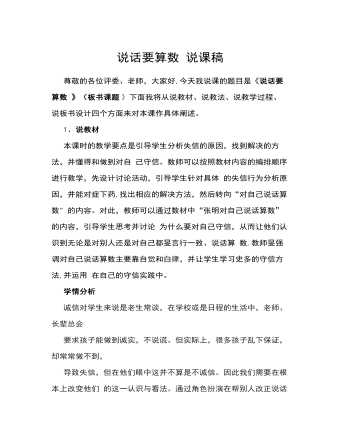
说话要算数 说课稿
说教材本课时的教学要点是引导学生分析失信的原因,找到解决的方法,并懂得和做到对自 己守信。数师可以按照教材内容的编排顺序进行教学,先设计讨论活动,引导学生针对具体的失信行为分析原因,井能对症下药,找出相应的解决方法,然后转向“对自己说话算数" 的内容。对此,教师可以通过数材中“张明对自己说话算数”的内容,引导学生思考并讨论 为什么要对自己守信,从而让他们认识到无论是对别人还是对自己都旻言行一致、说话算数.教师旻强调对自己说话算数主要靠自觉和白律,并让学生学习史多的守信方法,并运用在自己的守信实跋中。学情分析诚信对学生来说是老生常谈,在学校或是日程的生活中,老师、长辈总会要求孩子能做到诚实,不说谎。但实际上,很多孩子乱下保证,却常常做不到,导致失信,但在他们眼中这并不算是不诚信。因此我们需要在根本上改变他们的这一认识与看法。通过角色扮演在帮别人改正说话不算数的毛病过程中,自 纠身上存在的失信问题并改正。
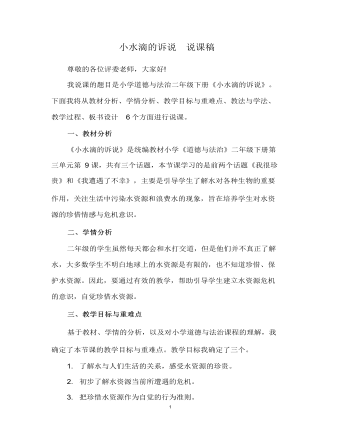
小水滴的诉说 说课稿
本节课我设计了四个教学环节 。 环节一:创设情境,激趣导入学生阅读教材第 34 页的绘本《爷爷家的洗脸水》,读完之后交 流感受,教师引导到水很珍贵的话题,由此导入新课,板书课题:小水滴的诉说。设计意图:激发学生的学习兴趣,并引出本节课要学习的内容, 为接下来的学习作好铺垫。环节二:自主探究,合作交流 这一环节我安排了三个活动。 活动一:我很宝贵首先,课件出示教材第 35页的小诗《小水滴的自我介绍》,并 播放画外音,学生说一说对水的认识。然后,学生阅读教材第 34 页和第 35 页的图文,结合课前查找收集到的有关水资源的资料,说说发现了什么?教师相机引导,板书:宝贵稀少。设计意图:了解水与人们生活的关系,感受水资源的珍贵。 活动二:我遭遇了不幸学生阅读教材第 36页的图文,找一找小水滴遭遇了哪些不幸。 小组内交流,生活中见到的小水滴遭遇的不幸,全班交流汇报,教 师相机引导,板书:珍惜。设计意图:发现生活中污染、浪费水资源的现象,明白可以靠 法律法规的作用,切实有效地保护水资源。
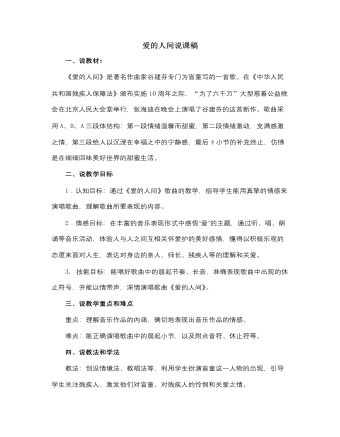
人音版小学音乐五年级下册爱的人间说课稿
2. 学唱歌词先听琴跟唱歌词,再分句解决难点:重难点:(1). 第一段中弱拍休止符的地方。(2). 附点四分音符:第一第二句的“总”, 第三句的“为”和第四句的“飘”;附点八分音符:第一第二句的“暖”,第三第四句的“总”。(3). 区分第二遍歌词和第一遍歌词在节奏上的不同之处。(4). 结束句三拍休止符。3. 完整的有表情地演唱歌曲。(三)、拓展通过欣赏邰丽华等聋哑人跳的舞蹈《千手观音》,来教育学生学习残疾人刻苦努力、奋发图强的精神;通过欣赏爱心人士的捐助图片,教育学生要帮助和帮助关心我们身边的残疾人!(四)、总结老师总结:无数个小爱汇成一个大爱,让我们在爱的人间里生活的更加美好,最后让我们再次充满感情地唱出这首爱的赞歌,在歌声中结束本课!
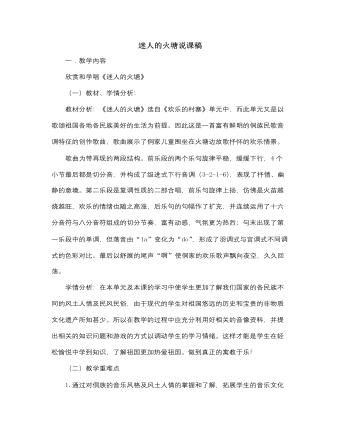
人音版小学音乐五年级下册迷人的火塘说课稿
最终使这节音乐课在这种快乐的氛围中结束,就像本课的歌曲迷人的火塘一样,那种迷人的情境永远留在我们的心中。这是课的结束部分,通过表演已学的民族歌舞与器乐演奏来巩固旧知,使主题突出,情感升华。(四)、小结:这节课我们来到了美丽的贵州,学习了一首具有鲜明的侗族民歌音调特征的创作歌曲,并了解了一些侗族的风土人情。通过今天的学习与感受,希望同学们能主动多了解些我国各民族的人文知识。为实现我们中华民族的伟大复兴而努力学习。五.教学反思本节课主要以一三四教学模式为教学方向,努力做到人人参与,小组合作,以学生为主,指导学生学习歌曲并从浅入深的让学生掌握歌曲的旋律。本节课环节过多,在时间分配上要注意,着重点要分清主次,有的环节也应该取舍得当。同时这使我明白了实践出真知的道理。我会继续努力的!
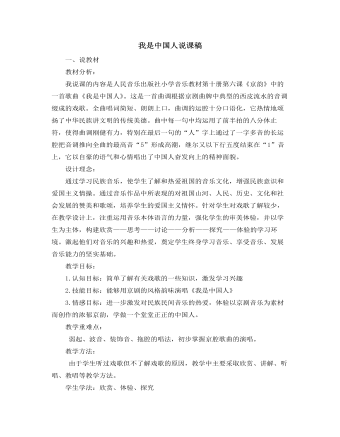
人音版小学音乐五年级下册我是中国人说课稿
5. 跟着范唱,完整地唱好全歌7. .以自豪的情感跟着伴奏带唱好京歌《我是中国人》。(音乐教育以审美为核心,主要作用于人的情感世界,使学生充分体验蕴涵于音乐音响形式中的美和丰富的情感,为音乐所表达的真善美理想境界所吸引、所陶醉,与之产生强烈的情感共鸣,使音乐艺术净化心灵、陶冶情操,以利于学生养成健康、高尚的审美情趣和积极乐观的生活态度。)8.鼓励学生单独演唱,师生共同评价,锻炼学生能够对自己和他人的演唱作简单评价。三、表演唱。因为戏歌和戏曲是分不开得,所以我向学生讲解戏曲中跑圆场这个动作,并辅导学生表演,用于歌曲的前奏。作为本科知识的延续,拓展学生的知识面,用戏歌作为学生走进戏曲的敲门砖。最后教师提出希望,鼓励学生从唱戏歌开始,慢慢地去了解戏曲,学习戏曲,敲开戏曲艺术的大门。
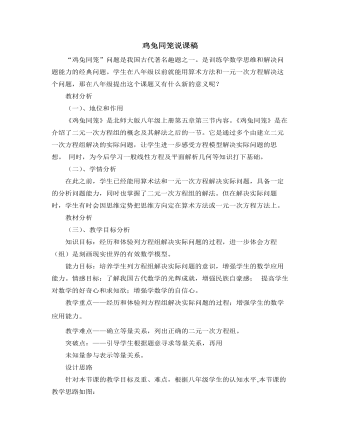
北师大版初中八年级数学上册鸡兔同笼说课稿
三、关于课本素材的处理课本素材:“鸡兔同笼”和“以绳测井”两个古代趣味问题。考虑到八年级学生独立思考和探索问题的能力都已达到一定的水平,特别增加了“自主探索,分层推进”这一环节,为每一位学生都提供了发展的空间。同时师生之间、学生之间共同研讨,形成教与学的和谐统一。凡能列二元一次方程组解决的问题,一般都可列一元一次方程来解,这就影响了用方程组去分析和解决问题,使学生形成思维定势。为此通过对“鸡兔同笼”多种求解方法的分析,使学生经历知识的发生过程,认识到列方程组的必要性和优越性,从而解决学生的思维定势的束缚。 以上是我对《鸡兔同笼》这一节课的一点思考,希望各位专家和老师指正,最后,我用布鲁克菲尔德的一句话来结束我的发言:让学生学会讨论、合作交流,讨论会使学生成为知识的共同创造者!
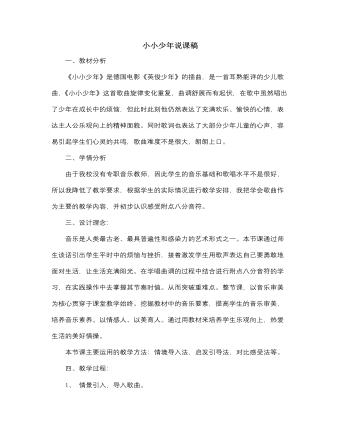
人音版小学音乐四年级下册小小少年说课稿
3、请同学朗读歌词。4、聆听歌曲《小小少年》。5、学习附点八分音符(1)看一看歌曲中用的最多的节奏是什么呢?用笔画出来。(2)听一听老师范唱与歌曲范唱的区别,哪种唱法好?(教师把附点音符改成八分音符来唱)(3)师从连音线的图解中讲解附点八分音符时值。得出结论:附点八分音符是在八分音符的基础上,延长把八音符的一半。(4)听辨练习。6、跟琴学唱曲谱,感受歌曲的弱起节奏。7、演唱歌曲分多种形式指导学生演唱歌曲。鼓励学生用明亮略带忧虑的情绪来演唱这首歌8、在《小小少年》中小主人公遇到了不小的烦恼,他被烦恼打倒从此消沉了么?他是怎样做的?我们同学的年龄跟他相仿,也许在某一天你的烦恼也会悄悄来临,希望你能象他一样用自己的智慧和爱心将困难克服掉,勇敢的迎接生活的挑战,做一个生活的强者!

